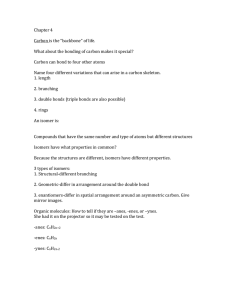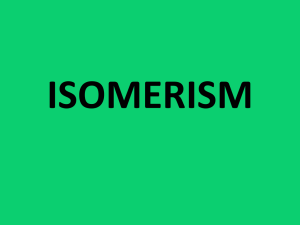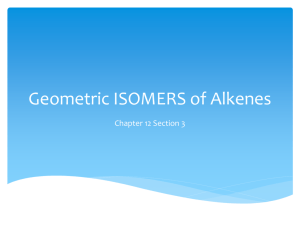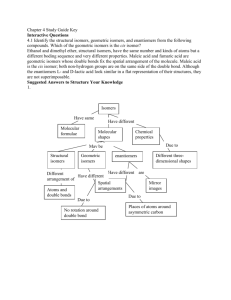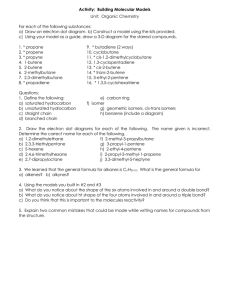CHMSC CRIM NAT SCI 11-GENERAL CHEMISTRY Organic
advertisement
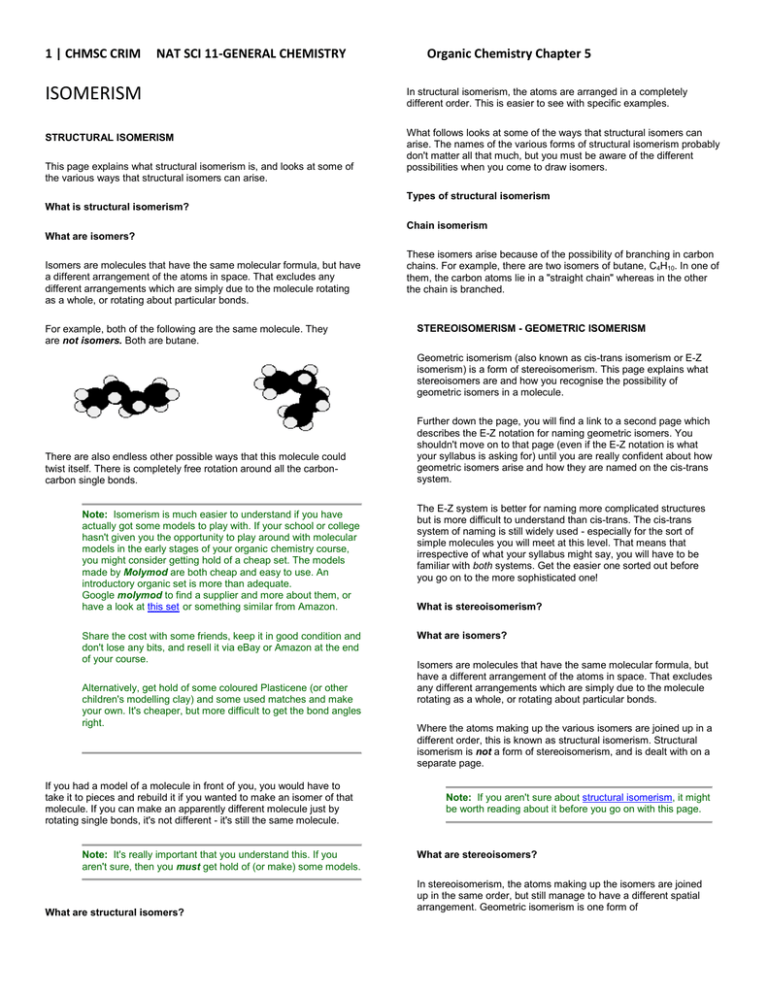
1 | CHMSC CRIM NAT SCI 11-GENERAL CHEMISTRY Organic Chemistry Chapter 5 ISOMERISM In structural isomerism, the atoms are arranged in a completely different order. This is easier to see with specific examples. STRUCTURAL ISOMERISM What follows looks at some of the ways that structural isomers can arise. The names of the various forms of structural isomerism probably don't matter all that much, but you must be aware of the different possibilities when you come to draw isomers. This page explains what structural isomerism is, and looks at some of the various ways that structural isomers can arise. Types of structural isomerism What is structural isomerism? Chain isomerism What are isomers? Isomers are molecules that have the same molecular formula, but have a different arrangement of the atoms in space. That excludes any different arrangements which are simply due to the molecule rotating as a whole, or rotating about particular bonds. For example, both of the following are the same molecule. They are not isomers. Both are butane. These isomers arise because of the possibility of branching in carbon chains. For example, there are two isomers of butane, C4H10. In one of them, the carbon atoms lie in a "straight chain" whereas in the other the chain is branched. STEREOISOMERISM - GEOMETRIC ISOMERISM Geometric isomerism (also known as cis-trans isomerism or E-Z isomerism) is a form of stereoisomerism. This page explains what stereoisomers are and how you recognise the possibility of geometric isomers in a molecule. There are also endless other possible ways that this molecule could twist itself. There is completely free rotation around all the carboncarbon single bonds. Note: Isomerism is much easier to understand if you have actually got some models to play with. If your school or college hasn't given you the opportunity to play around with molecular models in the early stages of your organic chemistry course, you might consider getting hold of a cheap set. The models made by Molymod are both cheap and easy to use. An introductory organic set is more than adequate. Google molymod to find a supplier and more about them, or have a look at this set or something similar from Amazon. Share the cost with some friends, keep it in good condition and don't lose any bits, and resell it via eBay or Amazon at the end of your course. Alternatively, get hold of some coloured Plasticene (or other children's modelling clay) and some used matches and make your own. It's cheaper, but more difficult to get the bond angles right. If you had a model of a molecule in front of you, you would have to take it to pieces and rebuild it if you wanted to make an isomer of that molecule. If you can make an apparently different molecule just by rotating single bonds, it's not different - it's still the same molecule. Note: It's really important that you understand this. If you aren't sure, then you must get hold of (or make) some models. What are structural isomers? Further down the page, you will find a link to a second page which describes the E-Z notation for naming geometric isomers. You shouldn't move on to that page (even if the E-Z notation is what your syllabus is asking for) until you are really confident about how geometric isomers arise and how they are named on the cis-trans system. The E-Z system is better for naming more complicated structures but is more difficult to understand than cis-trans. The cis-trans system of naming is still widely used - especially for the sort of simple molecules you will meet at this level. That means that irrespective of what your syllabus might say, you will have to be familiar with both systems. Get the easier one sorted out before you go on to the more sophisticated one! What is stereoisomerism? What are isomers? Isomers are molecules that have the same molecular formula, but have a different arrangement of the atoms in space. That excludes any different arrangements which are simply due to the molecule rotating as a whole, or rotating about particular bonds. Where the atoms making up the various isomers are joined up in a different order, this is known as structural isomerism. Structural isomerism is not a form of stereoisomerism, and is dealt with on a separate page. Note: If you aren't sure about structural isomerism, it might be worth reading about it before you go on with this page. What are stereoisomers? In stereoisomerism, the atoms making up the isomers are joined up in the same order, but still manage to have a different spatial arrangement. Geometric isomerism is one form of 2 | CHMSC CRIM NAT SCI 11-GENERAL CHEMISTRY Organic Chemistry Chapter 5 stereoisomerism. Geometric (cis / trans) isomerism How geometric isomers arise These isomers occur where you have restricted rotation somewhere in a molecule. At an introductory level in organic chemistry, examples usually just involve the carbon-carbon double bond - and that's what this page will concentrate on. Think about what happens in molecules where there isunrestricted rotation about carbon bonds - in other words where the carbon-carbon bonds are all single. The next diagram shows two possible configurations of 1,2-dichloroethane. Note: In the model, the reason that you can't rotate a carbon-carbon double bond is that there are two links joining the carbons together. In reality, the reason is that you would have to break the pi bond. Pi bonds are formed by the sideways overlap between p orbitals. If you tried to rotate the carbon-carbon bond, the p orbitals won't line up any more and so the pi bond is disrupted. This costs energy and only happens if the compound is heated strongly. If you are interested in the bonding in carbon-carbon double bonds, follow this link. Be warned, though, that you might have to read several pages of background material and it could all take a long time. It isn't necessary for understanding the rest of this page. Drawing structural formulae for the last pair of models gives two possible isomers. In one, the two chlorine atoms are locked on opposite sides of the double bond. This is known as the trans isomer. (trans : from latin meaning "across" - as in transatlantic). In the other, the two chlorine atoms are locked on the same side of the double bond. This is know as the cis isomer. (cis : from latin meaning "on this side") These two models represent exactly the same molecule. You can get from one to the other just by twisting around the carboncarbon single bond. These molecules are not isomers. If you draw a structural formula instead of using models, you have to bear in mind the possibility of this free rotation about single bonds. You must accept that these two structures represent the same molecule: The most likely example of geometric isomerism you will meet at an introductory level is but-2-ene. In one case, the CH3 groups are on opposite sides of the double bond, and in the other case they are on the same side. But what happens if you have a carbon-carbon double bond - as in 1,2-dichloroethene? The importance of drawing geometric isomers properly It's very easy to miss geometric isomers in exams if you take short-cuts in drawing the structural formulae. For example, it is very tempting to draw but-2-ene as These two molecules aren't the same. The carbon-carbon double bond won't rotate and so you would have to take the models to pieces in order to convert one structure into the other one. That is a simple test for isomers. If you have to take a model to pieces to convert it into another one, then you've got isomers. If you merely have to twist it a bit, then you haven't! CH3CH=CHCH3 If you write it like this, you will almost certainly miss the fact that there are geometric isomers. If there is even the slightest hint in a 3 | CHMSC CRIM NAT SCI 11-GENERAL CHEMISTRY Organic Chemistry Chapter 5 question that isomers might be involved, always draw compounds containing carbon-carbon double bonds showing the correct bond angles (120°) around the carbon atoms at the ends of the bond. In other words, use the format shown in the last diagrams above. How to recognise the possibility of geometric isomerism You obviously need to have restricted rotation somewhere in the molecule. Compounds containing a carbon-carbon double bond have this restricted rotation. (Other sorts of compounds may have restricted rotation as well, but we are concentrating on the case you are most likely to meet when you first come across geometric isomers.) If you have a carbon-carbon double bond, you need to think carefully about the possibility of geometric isomers. But you could make things even more different and still have geometric isomers: What needs to be attached to the carbon-carbon double bond? Note: This is much easier to understand if you have actually got some models to play with. If your school or college hasn't given you the opportunity to play around with molecular models in the early stages of your organic chemistry course, you might consider getting hold of a cheap set. The models made by Molymod are both cheap and easy to use. An introductory organic set is more than adequate. Googlemolymod to find a supplier and more about them, or have a look at this set or something similar from Amazon. Share the cost with some friends, keep it in good condition and don't lose any bits, and resell it via eBay or Amazon at the end of your course. Here, the blue and green groups are either on the same side of the bond or the opposite side. Or you could go the whole hog and make everything different. You still get geometric isomers, but by now the words cis and trans are meaningless. This is where the more sophisticated E-Z notation comes in. Alternatively, get hold of some coloured Plasticene (or other children's modelling clay) and some used matches and make your own. It's cheaper, but more difficult to get the bond angles right. Think about this case: Summary To get geometric isomers you must have: Although we've swapped the right-hand groups around, these are still the same molecule. To get from one to the other, all you would have to do is to turn the whole model over. You won't have geometric isomers if there are two groups the same on one end of the bond - in this case, the two pink groups on the left-hand end. So . . . there must be two different groups on the left-hand carbon and two different groups on the right-hand one. The cases we've been exploring earlier are like this: restricted rotation (often involving a carbon-carbon double bond for introductory purposes); two different groups on the left-hand end of the bond and two different groups on the right-hand end. It doesn't matter whether the left-hand groups are the same as the right-hand ones or not. Note: The rest of this page looks at how geometric isomerism affects the melting and boiling points of compounds. If you are meeting geometric isomerism for the first time, you may not need this at the moment. If you need to know about E-Z notation, you could follow this link at once to the next page. (But be sure that you understand what you have already read on this page first!) Alternatively, read to the bottom of this page where you will 4 | CHMSC CRIM NAT SCI 11-GENERAL CHEMISTRY find this link repeated. Organic Chemistry Chapter 5 also about bond polarity), it is essential that you follow this link before you go on. You need to know about van der Waals dispersion forces and dipole-dipole interactions, and to follow the link on that page to another about bond polarity if you need to. The effect of geometric isomerism on physical properties The table shows the melting point and boiling point of the cis and trans isomers of 1,2-dichloroethene. melting point (°C) boiling point (°C) cis -80 60 trans -50 48 isomer Use the BACK button on your browser to return to this page. Both molecules contain polar chlorine-carbon bonds, but in the cis isomer they are both on the same side of the molecule. That means that one side of the molecule will have a slight negative charge while the other is slightly positive. The molecule is therefore polar. In each case, the higher melting or boiling point is shown in red. You will notice that: the trans isomer has the higher melting point; the cis isomer has the higher boiling point. This is common. You can see the same effect with the cis and trans isomers of but-2-ene: melting point (°C) boiling point (°C) cis-but2-ene -139 4 transbut-2ene -106 1 isomer Why is the boiling point of the cis isomers higher? There must be stronger intermolecular forces between the molecules of the cis isomers than between trans isomers. Because of this, there will be dipole-dipole interactions as well as dispersion forces - needing extra energy to break. That will raise the boiling point. A similar thing happens where there are CH3 groups attached to the carbon-carbon double bond, as in cis-but-2-ene. Alkyl groups like methyl groups tend to "push" electrons away from themselves. You again get a polar molecule, although with a reversed polarity from the first example. Note: The term "electron pushing" is only to help remember what happens. The alkyl group doesn't literally "push" the electrons away - the other end of the bond attracts them more strongly. The arrows with the cross on (representing the more positive end of the bond) are a conventional way of showing this electron pushing effect. Taking 1,2-dichloroethene as an example: Both of the isomers have exactly the same atoms joined up in exactly the same order. That means that the van der Waals dispersion forces between the molecules will be identical in both cases. The difference between the two is that the cis isomer is a polar molecule whereas the trans isomer is non-polar. Note: If you aren't sure about intermolecular forces (and By contrast, although there will still be polar bonds in the trans isomers, overall the molecules are non-polar. 5 | CHMSC CRIM NAT SCI 11-GENERAL CHEMISTRY Organic Chemistry Chapter 5 Be careful not to draw "false" isomers which are just twisted versions of the original molecule. For example, this structure is just the straight chain version of butane rotated about the central carboncarbon bond. You could easily see this with a model. This is the example we've already used at the top of this page. The slight charge on the top of the molecule (as drawn) is exactly balanced by an equivalent charge on the bottom. The slight charge on the left of the molecule is exactly balanced by the same charge on the right. This lack of overall polarity means that the only intermolecular attractions these molecules experience are van der Waals dispersion forces. Less energy is needed to separate them, and so their boiling points are lower. Pentane, C5H12, has three chain isomers. If you think you can find any others, they are simply twisted versions of the ones below. If in doubt make some models. Why is the melting point of the cis isomers lower? You might have thought that the same argument would lead to a higher melting point for cis isomers as well, but there is another important factor operating. In order for the intermolecular forces to work well, the molecules must be able to pack together efficiently in the solid. Trans isomers pack better than cis isomers. The "U" shape of the cis isomer doesn't pack as well as the straighter shape of the trans isomer. The poorer packing in the cis isomers means that the intermolecular forces aren't as effective as they should be and so less energy is needed to melt the molecule - a lower melting point. Position isomerism In position isomerism, the basic carbon skeleton remains unchanged, but important groups are moved around on that skeleton. For example, there are two structural isomers with the molecular formula C3H7Br. In one of them the bromine atom is on the end of the chain, whereas in the other it's attached in the middle. Note: Although the chain is drawn as straight, in reality it's anything but straight. If you aren't happy about the ways ofdrawing organic molecules, follow this link. If you made a model, there is no way that you could twist one molecule to turn it into the other one. You would have to break the bromine off the end and re-attach it in the middle. At the same time, you would have to move a hydrogen from the middle to the end. Another similar example occurs in alcohols such as C4H9OH Use the BACK button on your browser to return to this page. These are the only two possibilities provided you keep to a four carbon 6 | CHMSC CRIM NAT SCI 11-GENERAL CHEMISTRY Organic Chemistry Chapter 5 chain, but there is no reason why you should do that. You can easily have a mixture of chain isomerism and position isomerism - you aren't restricted to one or the other. So two other isomers of butanol are: Note: To repeat the warning given earlier: If you are asked to draw the structural isomers from a given molecular formula, don't forget to think about all the possibilities. Can you branch the carbon chain? Can you move a group around on that chain? Is it possible to make more than one type of compound? Note: It's essential if you are asked to draw isomers in an exam not to restrict yourself to chain isomers or position isomers. You must be aware of all the possibilities. You can also get position isomers on benzene rings. Consider the molecular formula C7H7Cl. There are four different isomers you could make depending on the position of the chlorine atom. In one case it is attached to the side-group carbon atom, and then there are three other possible positions it could have around the ring - next to the CH3 group, next-but-one to the CH3 group, or opposite the CH3 group. Functional group isomerism In this variety of structural isomerism, the isomers contain different functional groups - that is, they belong to different families of compounds (different homologous series). For example, a molecular formula C3H6O could be either propanal (an aldehyde) or propanone (a ketone). There are other possibilities as well for this same molecular formula for example, you could have a carbon-carbon double bond (an alkene) and an -OH group (an alcohol) in the same molecule. Another common example is illustrated by the molecular formula C3H6O2. Amongst the several structural isomers of this are propanoic acid (a carboxylic acid) and methyl ethanoate (an ester). Be careful though! If you are asked to draw the structures of esters with the molecular formula C3H6O2, you aren't going to get a lot of credit for drawing propanoic acid, even if it is a valid isomer.


